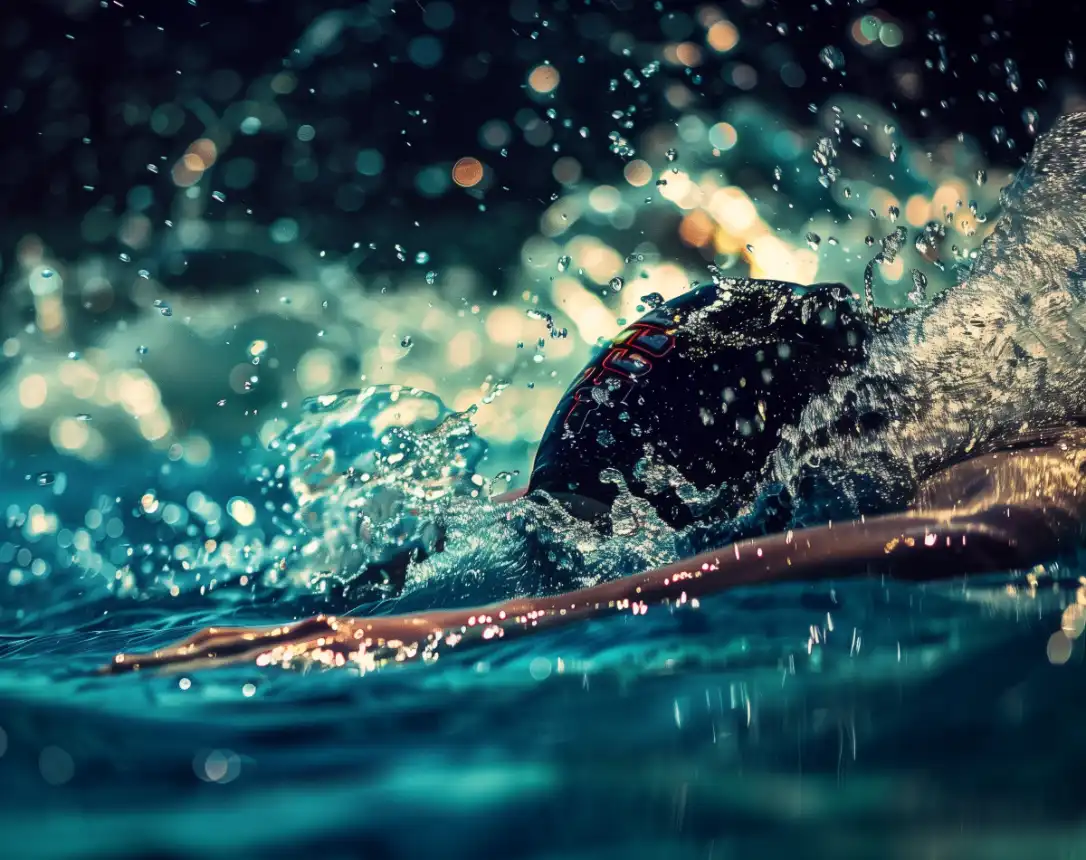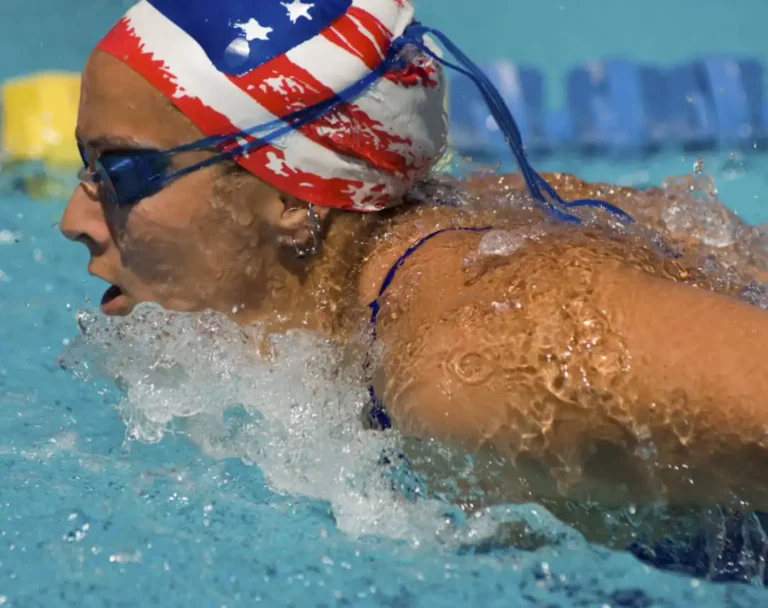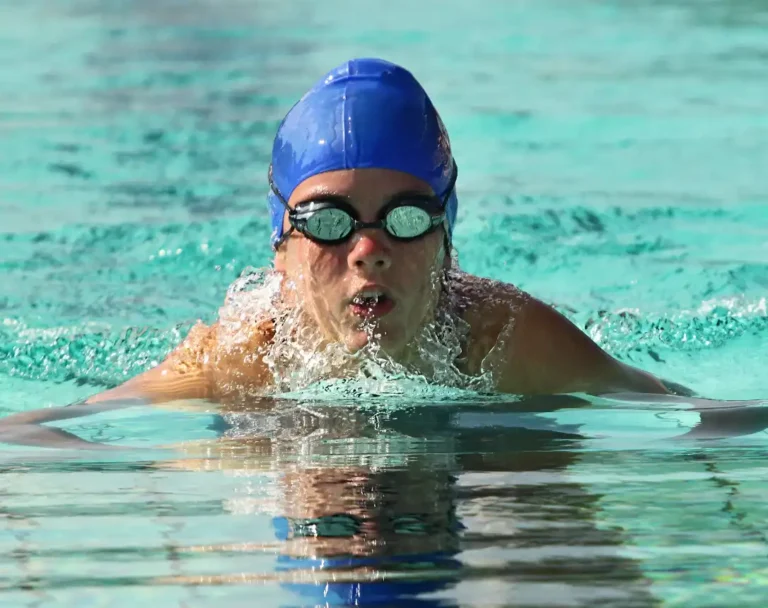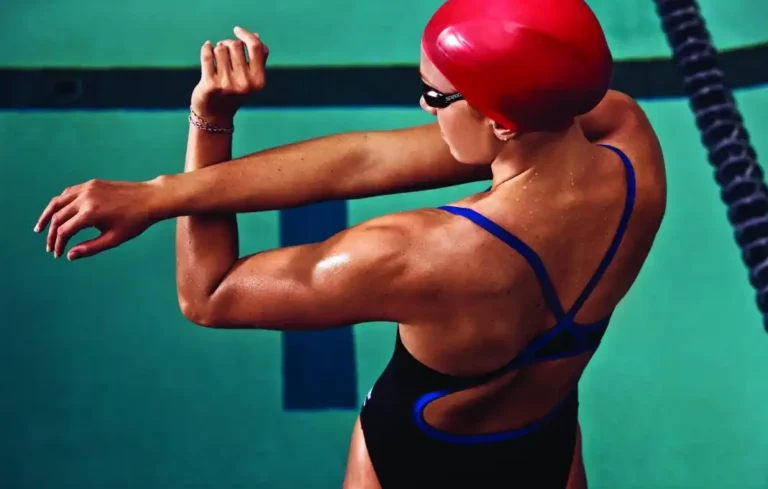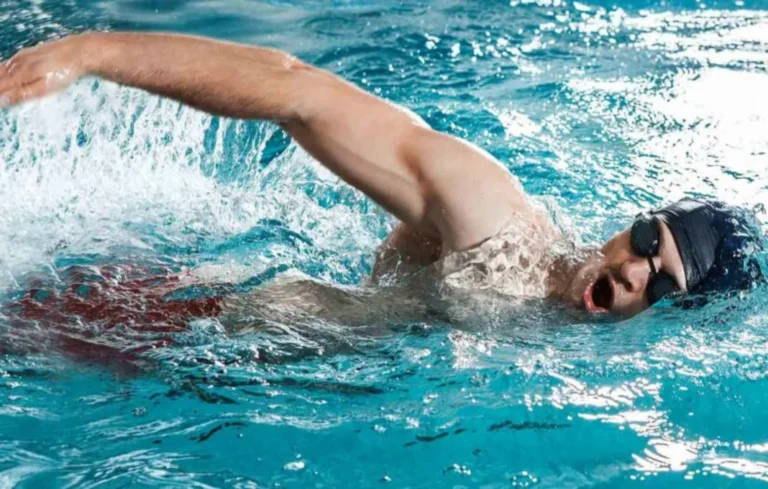I’ve always been mesmerized by the different types of swimming, each with its own rhythm and challenge. From the graceful breaststroke that reminds me of a serene ballet in water to the adrenaline-pumping freestyle, racing my own shadow.
There’s also the backstroke, where I lie back and slice through the water, looking up at the sky as if I’m part of it. And the butterfly – a stroke that demands strength and coordination, yet when perfected, makes me feel like I’m flying just above the surface. Each style has taught me not just how to move, but how to feel the water’s embrace.
Swimming Basics
As I wade into the world of swimming, my enthusiasm bubbles over—it’s like exploring a whole new dimension where age and ability don’t bound you. I instantly appreciate how the water embraces every swimmer, whether you’re a spry beginner or someone revisiting an old passion.
Equipment
- Swimsuit: Essential for comfort and efficiency.
- Goggles: Protect your eyes and improve underwater vision.
- Swim Cap: Keeps your hair out of the way and reduces drag.
I quickly learn that swimming is an art of balance and rhythm. With every stroke, my triceps work in harmony with the flutter kick of my legs, guiding me through the water with grace and strength. Regular practice boosts not just my muscle power but also my lung capacity and control over breathing.
Breathing is its own science in this aquatic realm. Mastering the right breathing technique makes all the difference, enabling me to swim longer and more efficiently—effortlessly cutting through the water while burning calories without overstressing my joints.
Flutter Kick and Arm Movements
- Legs: A steady, alternating kick that propels you forward.
- Arms: A smooth, rotational movement to pull water and assist in forward movement.
Swimming showcases its versatility as not just a sport but a vital life skill. Whether I’m aiming for strength or endurance, it beckons me to dive into its depths. For anyone learning to swim, remember it’s about the synchronization of every part of your body, from your bone joints to your fingertips, with each motion fine-tuned through dedicated practice.
Swimming Strokes
Diving into the world of swimming strokes, I’ve found that each style embodies a unique combination of technique, efficiency, and muscle strength. It’s thrilling to see how swimmers harness control and coordination to slice through the water, balancing power and grace. So let’s take a closer look at these incredible strokes!
Freestyle
Freestyle, widely recognized for its speed, is the go-to stroke in swimming competitions. Known also as the front crawl, it involves alternating arm movements propelling me forward, combined with a continuous flutter kick. To achieve maximum efficiency, I focus on streamlining my body’s position, mastering precise timing, and exercising strong cardio and muscle strength.
Backstroke
When I switch to the Backstroke, I’m immediately on my back, moving through the water with an alternating arm movement that’s akin to the freestyle but in reverse. The flutter kick keeps my momentum, while working on my coordination and glides ensures faster speeds. This stroke requires impeccable timing and back muscle strength for proper execution.
Breaststroke
The Breaststroke is all about technique and timing. My arms perform a simultaneous half-circular movement underwater, complemented by a whip kick. Breathing is crucial in breaststroke, and the continuous propulsion and breathing pattern develops my endurance. Perhaps the most graceful of all, it’s a testament to control and strength.
Butterfly
For sheer excitement, nothing beats the Butterfly stroke. It involves a unique undulation of the body, a powerful dolphin kick, and a synchronous overwater recovery of the arms. Perfecting the butterfly stroke demands considerable arm movement strength, endurance, and precise timing, all tied together with a rhythmic breathing technique.
Other Strokes
Beyond these mainstays, there’s a rich variety in Other Strokes like the sidestroke and the trudgen. These styles may not feature in contemporary competition, but they offer a unique challenge in coordination and stroke technique, often employing scissor kicks and balancing less propulsion with increased drag.
Competitive Swimming
I’ve always been fascinated by the sheer thrill and discipline of competitive swimming. It’s not just a sport; it’s a comprehensive test of one’s dedication, with athletes constantly refining their techniques for that burst of speed, coordinating muscle strength and propulsion to slip through water, striving for efficiency in every movement. Through dedication, swimmers achieve remarkable cardiovascular fitness, with practice sessions that bolster both endurance and muscle strength.
Racing Techniques
Competitive swimmers employ various stroke techniques such as freestyle, breaststroke, backstroke, and butterfly, each with unique movements and breathing patterns. Speed in competitive swimming is a product of perfecting these techniques, with a keen focus on stroke technique and propulsion, particularly the underwater dolphin kick, which is essential for transitions. Swimmers also meticulously rehearse their start, turns, and finishes to shave precious seconds off their race times.
- Freestyle: For speed and efficiency
- Breaststroke: Requires timing and strength
- Backstroke: Focus on coordination and leg strength
- Butterfly: Demands power and endurance
Training Regimens
Swimmers undergo rigorous training regimens that often include interval training to improve speed and endurance. A typical session will mix short sprints with longer distances to enhance cardiovascular fitness. These exercises are designed to increase efficiency in the water, ensuring that the energy cost of each stroke is minimized while maximizing forward momentum. Practice and consistency are my mantras here, as they build the necessary muscle strength and refine every aspect of my technique.
- Interval Training: Alternating between sprints and steady swimming to build endurance and speed.
- Strength Training: Dryland exercises that focus on core muscle groups for power.
Swimming Regulations
Competitive types of swimming are governed by strict regulations to ensure fair competition. These rules cover everything from swimwear to the technical execution of strokes and turns in Olympic sports. As a swimmer, I am well-versed in these regulations, ensuring that my technique is not only efficient but also compliant with the standards set by governing bodies like FINA. Adhering to these principles is crucial for any competition I enter.
- FINA Compliance: Ensures fair play and standards in competitions.
- Technical Execution: Governs starts, strokes, turns, and finishes.
Health and Fitness Benefits
I’ve always been amazed at swimming’s incredible ability to boost health and fitness. Not only is it an exhilarating cardio exercise, but it also strengthens the body with a low impact on joints. Regardless of age or speed in the water, swimming propels you towards a fitter self with remarkable efficiency.
Swimming regularly can ramp up cardiovascular fitness by providing a wholesome cardiovascular workout. Our hearts and lungs thank us for each lap, with every stroke increasing lung capacity and heart strength. I often feel the rush of endorphins post-swim—a testament to its vast health benefits.
Here’s a breakdown:
- Cardiovascular workout: A consistent swim routine can lead to improved heart rate and blood pressure.
- Muscle strength: Frequent swimming can result in toned muscles, particularly the glutes, hamstrings, shoulder muscles, calves, and biceps.
- Propulsion and Efficiency: Through the repetitive nature of strokes, my muscular coordination and movement efficiency have significantly improved.
Swimming targets a wide range of muscle groups, unlike certain workouts that focus on specific areas. The harmonious action of pulling and kicking through the water engages my entire body, contributing to an all-encompassing muscle workout. Through regular practice, not only do I feel more agile, but my strength has soared notably. Whether it’s the pursuit of speed or the quest for longevity in the sport, swimming is undeniably a powerhouse for fostering robust health and vitality.
Types of Swimming for Different Demographics
From the thrilling rush of my first dive to the triumph of mastering a new stroke, swimming has been a transformative adventure for me. It’s a journey that caters to all ages and skill levels—from the giggles of children in swimming lessons to the focused determination of professionals gliding through the water.
Children and Swimming Lessons
Age Appropriate: Children as young as six months can begin their swimming journey, initiating water safety and comfort. With proper supervision, lessons typically start around the age of 4, stressing the importance of water safety and basic strokes.
- Learn to Swim: Structured lessons aim to teach children how to float, kick, and eventually swim independently.
- Safety First: A vital component is ensuring that children learn under vigilant lifeguard supervision to foster a secure learning environment.
Adult Beginners and Self-improvement
Adults starting their aquatic journey are often seeking self-improvement in areas such as strength, endurance, or simply a new hobby.
- Beginner Techniques: Adults learn fundamental skills such as breathing methods, stroke techniques, and buoyancy control.
- Building Endurance: As a beginner or someone returning to swimming after a break, the focus is on building endurance through progressive practice.
Training for Professionals
Competitive Edge: For expert swimmers, like competitive athletes and Navy SEALs, training is rigorous and tailored to elevate performance levels.
- Advanced Regimes: Intensive drills are designed to enhance speed, strength, and technical prowess.
- Lifeguard Fitness: Prospects for lifeguards endure specialized training to ensure water safety, rescue skills, and exceptional swimming strength.
Cultural and Historical Context
I’m thrilled to dive into how swimming has carved its place in our global fabric. It’s not just a sport; it’s a narrative that encapsulates the crescendo of cultural significance and historical milestones. Now, let’s plunge into the specifics!
Swimming in the Olympics
Swimming made its Olympic debut in 1896, and since then, it has anchored itself as a cornerstone of the games. Initially, Olympic swimming competitions were only open to men, but women dived into the scene in 1912. The United States and Australia are powerhouses in Olympic swimming, reflecting their countries’ investments in the sport. Here’s a brief glance at the Olympic evolution:
- London 2012: This event witnessed Michael Phelps becoming the most decorated Olympian of all time, with a staggering 22 medals.
- Beijing 2008: Featured the unforgettable eight gold medals won by Phelps, spotlighting swimming’s dramatic competitive edge.
Types of Swimming Around the World
Swimming is not merely a competitive endeavor; it also holds a sacred place in various cultures. From the sun-drenched coasts of Australia to the serene lakes in European countries, swimming is a beloved pastime, underscoring its global allure. In recent years, the popularity of recreational swimming has surged, with articles frequently highlighting the health benefits associated with the sport.
Iconic Swimmers and Influence
Michael Phelps, with his unmatched expertise, has not only shattered records but also inspired a legion of swimmers worldwide. His influence can’t be overstated; countless swimmers have taken their marks because of Phelps’ legacy. Swimming articles often spotlight his training regimen, diet, and mental preparation, igniting a passionate following and elevating swimming’s popularity to new heights.
Swimming Gear and Accessories
Stepping into the pool, I always feel a rush of excitement. It’s that wave of water beckoning me to dive into its cool embrace. But before I make the plunge, I know that gearing up is essential. Swimming isn’t just about technique; it’s also about the equipment. So, let’s dive into the world of swimming gear and accessories!
Essentials:
- Swimsuits: A good swimsuit is my second skin in the water. It reduces drag and improves speed.
- Goggles: They are my eyes underwater; keeping them snug prevents leaks and protects my vision.
- Caps: My cap keeps my hair out of my face and reduces resistance, making me more hydrodynamic.
Additional Gear:
- Kickboards: They’re great for isolating leg movements and improving kick technique.
- Pull Buoys: I use these between my thighs to focus on strengthening my upper body.
- Fins: They add resistance, strengthening my legs and improving my kick’s propulsion.
Maintenance Tools:
- Anti-Fog Spray: For goggles, this is a lifesaver! It keeps my vision clear for the entire swim.
- Mesh Bags: After I’m done, they’re perfect for storing wet gear and allowing it to dry out.
Without a doubt, the right gear can make all the difference. I make sure to choose accessories that complement my swimming style and keep me gliding through the water like a fish. Let’s suit up and swim on!
Safety and Supervision
Nothing thrills me more than diving into the aquatic adventures that swimming offers! But whenever I, or anyone else, approach the water, especially beginners like children, I always prioritize safety. To ensure a safe and enjoyable experience, water safety is of utmost importance.
- Always Supervise: Kids should never swim alone. I believe continuous, active supervision from a responsible adult is crucial. It’s even better if a certified lifeguard is on duty.
- Understand the Environment: Knowing your surroundings, whether it’s a pool, lake, or the ocean, can help prevent accidents. For me, staying aware of water depth, temperature, and currents is a must.
- Swimming Lessons: Beginners benefit immensely from formal swimming lessons. As I learned the proper techniques and water safety rules, my confidence in swimming grew, reducing my risk of accidents.
- Safety Gear: For kids or those just starting, using floatation devices can offer an additional layer of protection. But remember, these are not a replacement for supervision!
Every time I slip into my swimsuit, I double-check that these safety measures are in place. By following these simple steps, my aquatic experiences remain both exciting and secure. Let’s dive into the waters safely and create ripples of joy and confidence!
FAQ
Which type of swimming is best for beginners like me?
I found the breaststroke to be a gentle introduction, easing me into the water’s rhythm.
Do different strokes offer different benefits?
Absolutely. Freestyle boosts my cardio, breaststroke soothes my soul, backstroke relaxes my mind, and butterfly strengthens my will.
How do I choose which stroke to focus on?
I listen to my body and heart. Each day might call for a different dance with the water.
Exploring the types of swimming has opened up worlds within me. I’d love to hear about your journey with these strokes. Feel free to share in the comments or reach out on social media!

